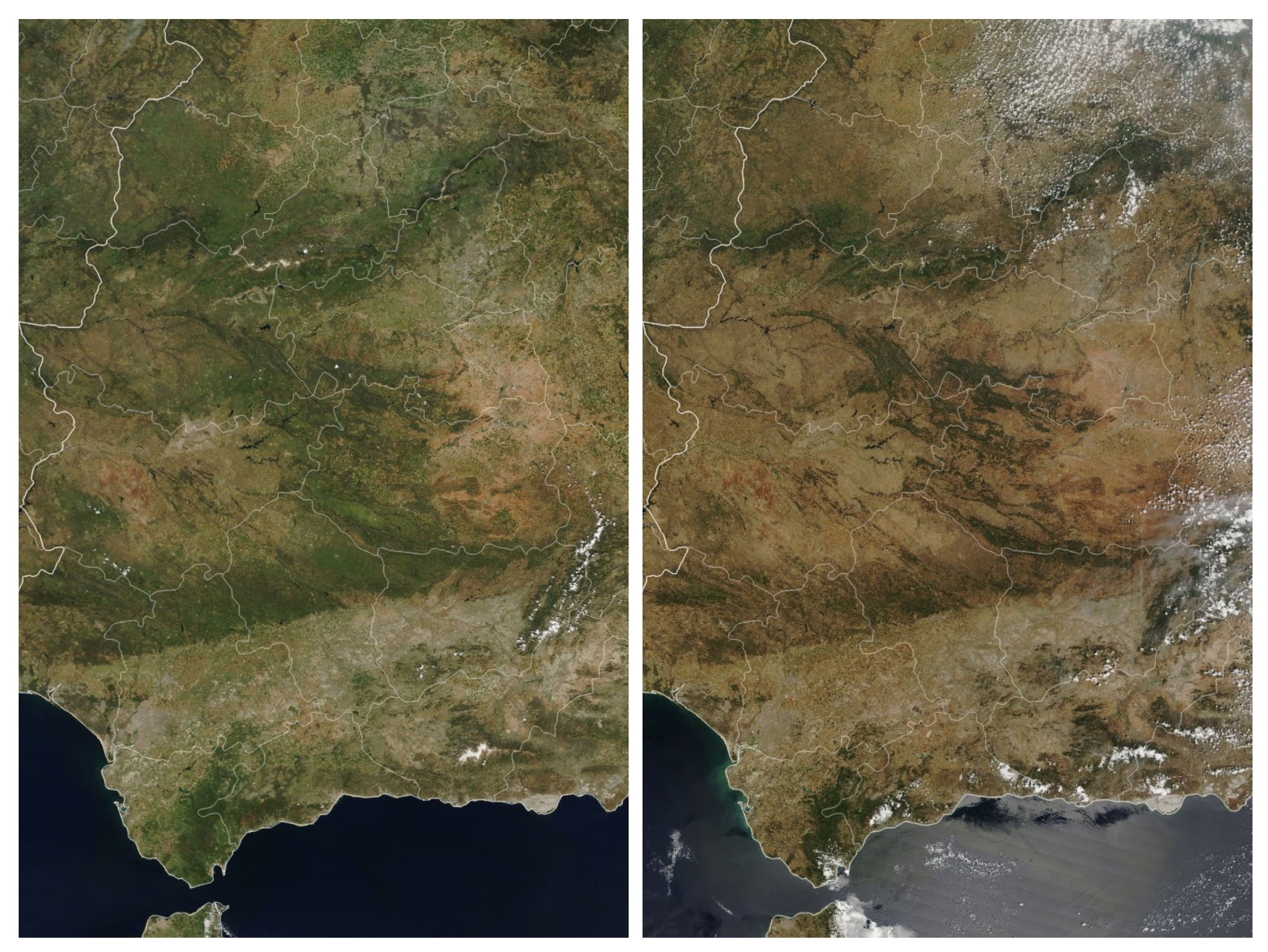

European drought
Most of southern and western Europe saw an exceptionally dry and warm winter 2022-23, according to a report issued in March 2023 by the European Drought Observatory in partnership with Copernicus. By springtime, the impacts of the emerging drought were already visible in France, Spain and northern Italy, raising concerns on water supply, agriculture and energy production.
This follows on from 2022, when Europe was affected by a significant drought due to a persistent lack of precipitation and the second lowest surface soil moisture in the last 50 years. According to the European State of Climate report for 2022 that was issued by Copernicus recently, lower than average precipitation along with above average temperatures and extreme heatwaves led to widespread and prolonged drought across much of Europe. And for some regions in Europe, drought continues to have a major impact into 2023, especially Italy, Spain and France.
Italy
Drought conditions in northern Italy have had a big impact on the levels of some of the rivers and lakes. During April 2023, the Po River, Italy’s longest river, reached its lowest level ever recorded in April. Meanwhile, Lake Garda, Italy’s largest lake, was at its lowest level in 70 years. Lake Garda is a crucial freshwater reservoir and the current capacity of the lake puts at risk its ability to sustain agriculture, local communities, tourism and navigation.
#ImageOfTheDay
— 🇪🇺 DG DEFIS #StrongerTogether (@defis_eu) April 18, 2023
Worrisome news related to #drought 🥀 continue to come from northern Italy 🇮🇹
➡️The Po River is at the lowest level ever recorded in April
⬇️Lake Garda, as seen in this #Copernicus #Sentinel2 🇪🇺🛰️ image of 16 April, is at its lowest level in 70 years pic.twitter.com/b64oZ5Jx6X
Spain
Drought is also having a major impact in Spain. Here the Sierra Boyera reservoir in the Cordoba province in Andalusia is one area being severely affected. At the beginning of March 2023, the reservoir was at only 1.3% of its total capacity, and a Copernicus Sentinel-2 image captured on 1 April 2023 showed that the reservoir was completely empty. This is having severe consequences on the local flora and fauna.

Both February and March 2023 were very dry months for much of Spain. According to AEMet (Spanish Meteorological Agency) mainland Spain recorded around a third of the average monthly rainfall during both of the months. The very dry conditions have also continued into April.
During February 2023, mainland Spain recorded just 33% of the average monthly rainfall, making it the 9th driest February since the beginning of the series in 1961.

Mainland Spain then recorded just 36% of the normal average rainfall in March 2023. Making it the 6th driest March for Spain since the start of the rainfall series in 1961.

Although January did see abundant rainfall, according to AEMet, since the beginning of the year rainfall for Spain is only around 50% of the normal average, for the period January to mid-April.

The fact that March and much of April 2023 were such dry months exacerbated the drought conditions already affecting parts of Spain. According to the European Drought Observatory, southern and north-eastern Spain are some of the areas most affected by persistent drought and water scarcity. In these parts of Spain some of the reservoirs are much lower than would be expected for the time of year.
Andalusia is one region most affected by drought, particularly the area of the Guadalquivir River Basin. According to Copernicus, consecutive years of low rainfall and high temperatures have led to the reservoirs in the basin currently being at a low capacity of just 25.5%, which is 36.5% below the average of the last 25 years. This is having a significant impact on the agricultural industry and biodiversity in the area.
The Copernicus Sentinel-2 images below show how agriculture in the area has suffered significant damage due to the dry conditions. The impact of the drought has also extended to the Doñana National Park and image below for April 2023 shows that the permanent water bodies in the park appear dry, which poses a threat to the survival of the wildlife that relies on these water sources.

According to AEMet April 2023 was the warmest and driest April since 1961 for Andalusia. Average temperatures were almost 4 °C above average.
#AEMETCalor. Abril de 2023 ha sido el más cálido y seco desde 1961, con una nomalía en las temperaturas medias de +3.9C y una precipitación media de tan solo 5.5 litros/m2, un 4% de la media del periodo de refrencia 1991-2020. Los datos son escalofriantes o más bien, agobiantes!! pic.twitter.com/iGGN05GC3r
— AEMET_Andalucía (@AEMET_Andalucia) May 4, 2023
It was reported in March 2023 that water restrictions due to the lack of rain were put in place in Barcelona and the northeast region of Catalonia. The measures included banning the use of drinking water to wash the exterior of houses and cars as well as filling swimming pools. There are also measures in place to reduce the amount of water used for irrigation.
Despite it being early in the season, wildfires were also reported in parts of northern Spain.
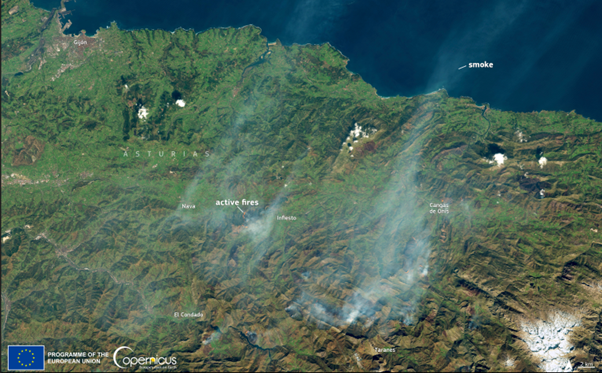

France
France is another region in Europe where drought conditions and wildfires have had a major impact. According to the French Meteorological Agency Meteo France, rain did not fall in France for 32 consecutive days at the start of 2023, from 21 January to 21 February inclusive. This is the longest period of dry weather for France (defined by the total accumulated rainfall across France being less than 1mm) since records began in 1959.
🌧️❌32 j consécutifs sans pluie* à l'échelle de la France. La plus longue série depuis 1959, devançant celle du 17/03/2020 au 16/04/2020 (31 jours consécutifs).
— Météo-France (@meteofrance) February 22, 2023
🌧️Cette série ne devrait pas se poursuivre, précipitations aujourd'hui.
*cumul des précipitations agrégé 🇫🇷 < 1 mm. https://t.co/nXZQo0SI0E pic.twitter.com/nuD7tyESTj
March and April 2023 did see much more in the way of rain. According to Meteo France there was 1.4 times the normal average monthly rainfall during March. However, despite the rainfall that has fallen in recently months, there are some regions of France that are still in severe deficit of rainfall.

One region of France severely impacted by drought conditions and wildfires is the Pyrénées-Orientales. Meteo France reported on 18 April 2023 that one of the stations in this region, Cap Béar, recorded just 230mm of rain in the past year — barely 36% of the annual average rainfall for this station, which is 626.2mm.
📊
— Météo-France (@meteofrance) April 18, 2023
🌧️ A Cap Béar, #PyrénéesOrientales, il est tombé 230 mm sur l'année écoulée contre 626 mm en moyenne.
🌡️ Dans le même temps, sur cette station, on a enregistré 12 mois consécutifs au-dessus des normales (13 peut-être avec avril). pic.twitter.com/4EfrnelPvQ
The French Pyrénées-Orientales department, which borders Spain’s Catalonia autonomous region, was officially declared to be in drought ‘crisis’ level, which means bans on washing cars, watering gardens and filling pools. This first set of water restrictions was put in place in an effort to conserve water resources and prioritises drinking water above other usages. The image below was taken by the Copernicus Sentinel-2 satellite on the 2nd of May and shows Perpignan, one of the most affected cities.
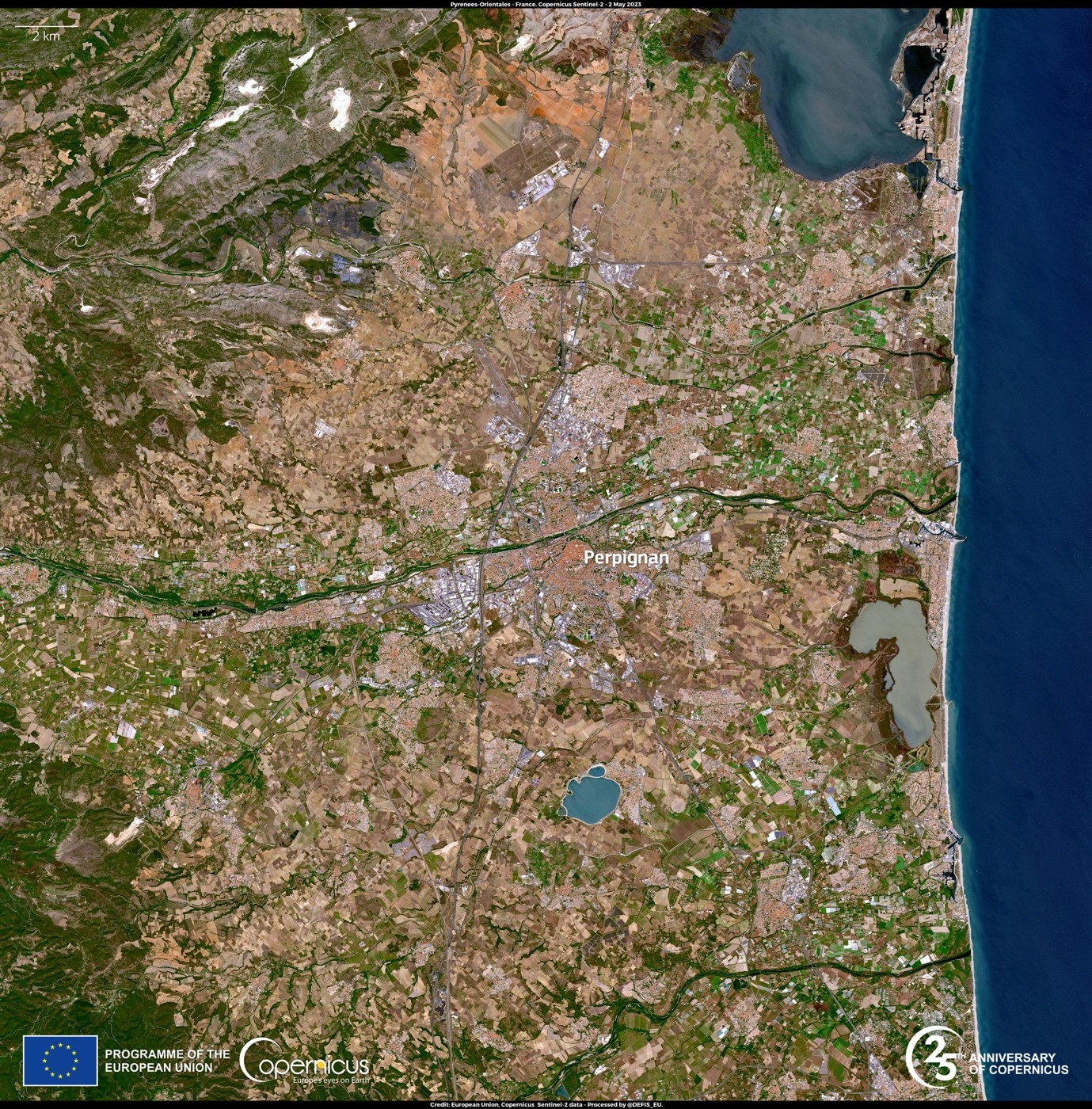
Wildfires also affected this region. On 16 April 2023 a wildfire broke out in the hills between Cerbère and Banyuls-sur-Mer in the Pyrénées-Orientales region of France and crossed the Spanish border. The fire spread quickly fuelled by dry vegetation and strong winds and burnt over 930 hectares of land, the equivalent of 2,000 football fields. Wildfires like this radically change the landscape and can leave a noticeable mark on the land referred to as a "burn scar". The burn scar left by the wildfire in the Pyrénées-Orientales region of France can be seen in the image below which was captured from space.
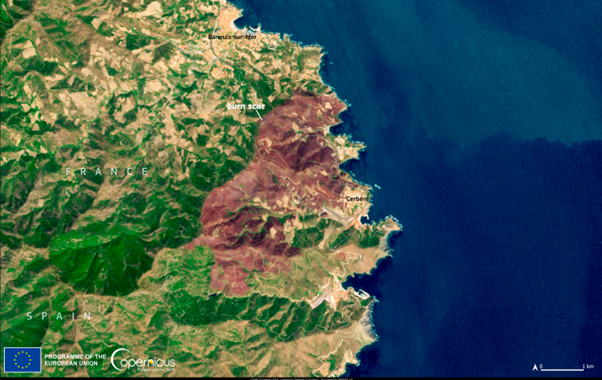
France saw a very early start to the wildfire season in 2023 with unseasonal wildfires affecting several areas of France in February and March. Copernicus reported that as of 16 April, the cumulative area burnt by wildfires in France for 2023 so far was well over three times the 2006-2022 average.
Unseasonal #wildfires have affected several areas of #France🇫🇷 in February and March
— Copernicus EMS (@CopernicusEMS) April 17, 2023
As of 16 April, the cumulative burnt area🔥 for 2023 is well over 3⃣ times above the 2006-2022 average‼️
More at👇https://t.co/wiZ0jhJKq4 pic.twitter.com/KZOCz4PMlA
End of April heatwave for Iberia
At the end of April, a spell of extreme heat impacted Iberia, during which mainland Spain and Portugal recorded temperatures that are usually seen in July and August, breaking temperature records. In Spain, Cordoba Airport in Andalusia, recorded a maximum temperature of 38.8C on Thursday 27 April, which is the highest April temperature on record for mainland Spain. As well as Spain and Portugal, the heatwave also impacted parts of Morocco and Algeria and temperatures for many were up to 20 degrees above average for the time of year.
Large parts of Spain and Portugal are gripped by heat and drought.
— World Meteorological Organization (@WMO) April 28, 2023
Cordoba airport set a new April temperature record for mainland Spain of 38.8°C on Thursday, says @AEMET_Esp#StateofClimate #ClimateChange pic.twitter.com/npsgbdOr00
The extreme heat at the end of April 2023 exacerbated the ongoing drought in Spain, which led to several salt lakes in the south of the country drying up. These salt lakes are important as they are habitats for migratory birds such as flamingos. The image below was taken by the Copernicus Sentinel-2 satellite on 26 April 2023, and shows that the famous Andalusian lake Fuente de Piedra, a favourite stopover for flamingos, is completely dry.
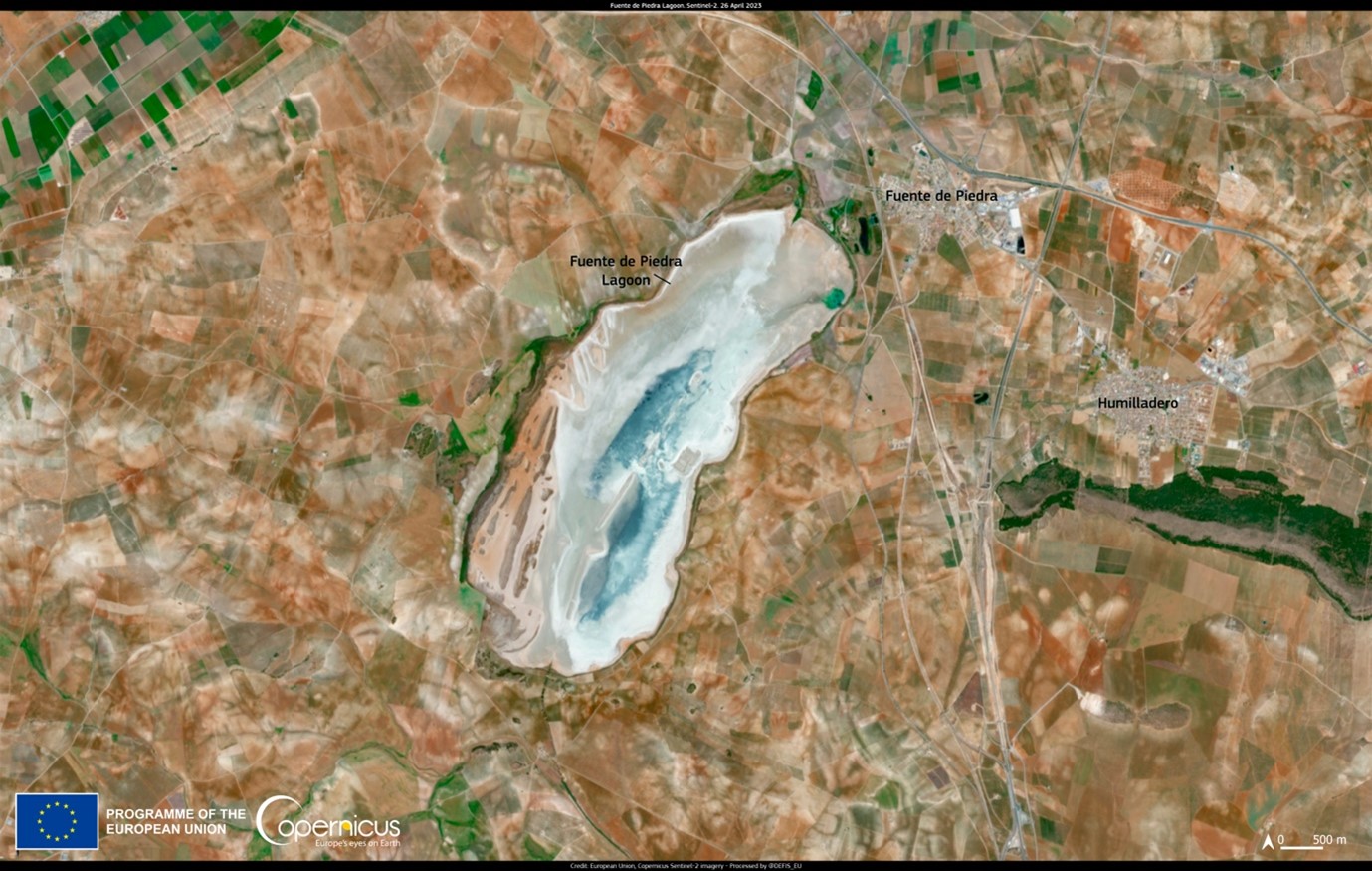
Extreme heat almost impossible without climate change
An attribution study issued by World Weather Attribution just eight days after the peak of the heatwave, showed that the extreme heat experienced in Spain, Portugal, Morocco and Algeria at the end of April 2023 was almost impossible without human-caused climate change. Scientists from Morocco, France, the Netherlands, the UK and the US collaborated to assess the extent to which human-induced climate change altered the likelihood and intensity of this early season heatwave. The study showed that the heatwave at the end of April was made 3.5 °C hotter and at least 100 times more likely by human-caused climate change.
Last week’s heatwave in Algeria, Morocco, Spain, and Portugal would have been virtually impossible in a world without human-caused climate change.
— World Weather Attribution (@WWAttribution) May 5, 2023
Our study found that climate change made the event 3.5°C hotter and at least 100 times more likely. https://t.co/mhEuWGeLmg
Europe has been warming faster than any other continent in recent decades, with temperatures increasing at twice the global average rate. This means that water scarcity and droughts are a growing threat for many parts of Europe. According to the European state of the climate report for 2022 that was issued in April 2023 by Copernicus, 2022 was the second warmest year on record for Europe. But the summer of 2022 was the warmest on record for Europe, with many countries affected by extreme heatwaves. The highest temperatures in western Europe were around 10 °C higher than typical summer maximum temperatures.

We know that climate change is making extreme weather events such as drought and heatwaves more frequent, intense and prolonged, and unfortunately we are already seeing the impacts of these severe weather events in Europe and elsewhere around the world.
About the Author
Gemma Plumb has been a meteorologist for over 15 years and is currently working for DTN as a media meteorologist at the BBC. She has also forecast for a variety of sectors including energy, media, transport and utilities.
Gemma is one of the creators and hosts of the weather podcast For the Love of Weather, which looks at the science behind weather and climate and how weather can impact our daily lives.
A keen science communicator, she is passionate about sharing her love of the weather. You can find Gemma on TikTok making funny, engaging and educational weather-related videos (@theweatherpud).





